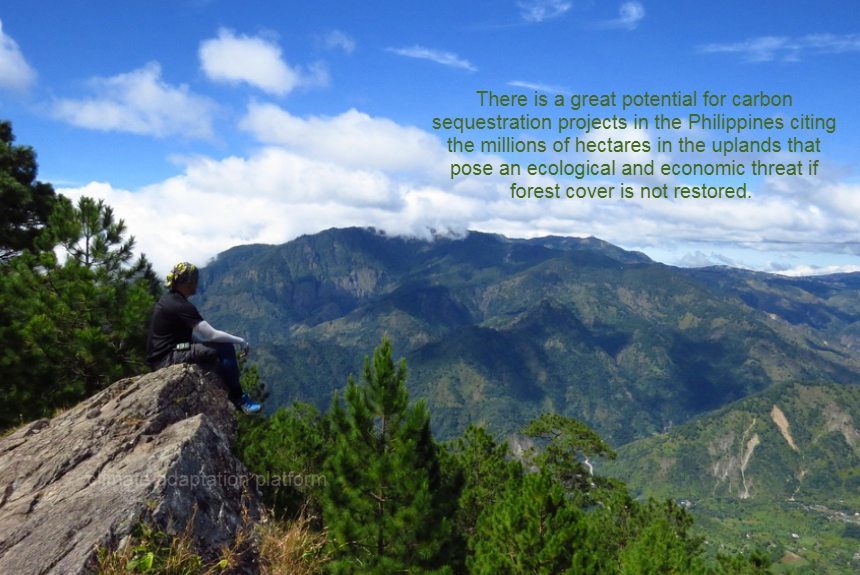A study examines the Philippines’ potential to participate in carbon sequestration projects aimed at mitigating climate change. Done in 2005, the study sees the Philippines, with its tropical forests, fallow areas, and vast areas of degraded land, as having the potential for carbon sequestration through reforestation and rehabilitation.
The study cites two carbon sink projects, the Laguna Lake Development Authority – Tanay and Conservation International Philippines.
The Laguna Lake Development Authority (LLDA) sells carbon sequestered through the Municipality of Tanay and the LLDA. The farmers from the Tanay watershed implemented the project from 2004 to 2014. were the implementors of the project.
The project promises to capture and sequester 3,204 tC in a high scenario and 1,424 tC under a low scenario, with corresponding values of US$70,540 and US$31,380, respectively.
Conservation International Philippines, through reforestation activities, expects to sequester a total of 512,000 tCO2e for 30 years.
The environmental services of these forests in mitigating climate change include the following:
- First, the conservation of existing carbon stock by protecting forest reserves.
- Second, carbon stocks will expand through increased carbon sequestration, resulting from the widening of forest areas and increased storage in durable wood products.
- Third, the substitution of wood products for fossil-based products.
For example, instead of cement-based products and other construction materials that are fossil-fuel intensive, construction materials and biofuels from forest timbers and trees can be a climate-friendly option.
Carbon sequestration activities have also provided additional benefits and services to the community. Through it, private lands were reforested that were previously bare.
The establishment of agroforestry farms on public lands has enabled the community to grow and harvest their crops, providing a source of livelihood and reducing their reliance on forest projects such as logging and slash-and-burn farming, which contribute to deforestation and land degradation. Forestation has also protected against soil erosion, especially along the riverbanks.
Reforestation projects are community-based and involve the community, local non-government organisations (NGOs), the local government, the Department of Environment and Natural Resources (DENR), the project’s monitoring team, and the funding organisation.
The World Bank, through its Carbon Fund, the BioCarbon Fund, was the only buyer of emissions reductions from both carbon sink projects at the time of the study.
The details of the carbon compensation mechanism are still being worked out. Answers to questions such as how the carbon income will be divided among stakeholders and farmers, and what projects will be financed from this income, are still being finalised.
The study concluded that there is great potential for carbon sequestration projects in the Philippines. It cited the millions of hectares of upland areas that pose an ecological and economic threat if forest cover is not restored.
The main challenge is a lack of a clear signal from the Philippine government on whether carbon sink projects are welcome in the country. Moreover, the study reveals a perception that carbon sink projects are not welcome. Neighbouring countries like China and Indonesia, on the other hand, are already starting their groundwork for carbon sequestration projects. If the Philippines is to take advantage of the carbon market, the Inter-Agency Committee on Climate Change (IACCC) needs to resolve this issue, according to a study (Lasco et al., 2005).
The Asian Development Bank’s 2016 report on Emission Trading Schemes in Asia and the Pacific lists the countries in the Asia Pacific with existing and emerging emission trading systems. The Philippines is not on the list, which means that it does not yet have a carbon emissions trading system in place as of the study’s date (Emissions Trading Schemes, 2016).
On 12 January 2017, the Philippines and Japan signed an agreement to establish a Joint Crediting Mechanism (JCM). Under this mechanism, Japan will implement various projects that will reduce its GHG emissions in the Philippines using its low-carbon technology (Japan and the Philippines, 2017).
It is reassuring to know that a study on the potential for establishing carbon sequestration projects in the Philippines has been conducted. Carbon sequestration projects have both environmental and economic impacts on the host countries.
It can enhance the climate adaptation strategies of countries vulnerable to the effects of climate change, like the Philippines.
Read the entire study by CLICKING the button below:
Sources:
Lasco, R., Pulhin, F., & Banaticla, M.R.N. (2005). Potential Carbon Sequestration Projects in the Philippines. Retrieved from http://old.worldagroforestry.org/sea/Publications/files/paper/PP0182-06.pdf.
Emissions trading schemes and their linking – challenges and opportunities in Asia and the Pacific Mandaluyong City, Philippines: Asian Development Bank, 2016. Retrieved from https://www.adb.org/sites/default/files/publication/182501/emissions-trading-schemes.pdf
Japan and the Philippines Concluded an Agreement to Establish a Joint Crediting Mechanism (JCM). (2017). Ministry of Economy, Trade and Industry. Retrieved from https://www.meti.go.jp/english/press/2017/0112_001.html



Leave a Reply